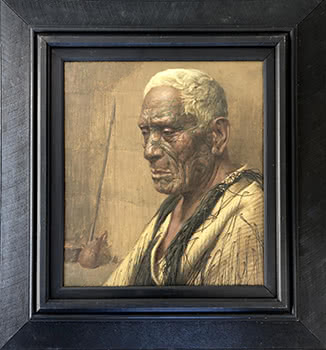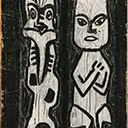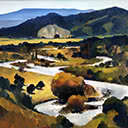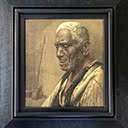Te Hau-Takiri Wharepapa
49 x 43.5 cm
est. $1,500,000 - 2,500,000
PROVENANCE
Collection of artist, gifted to his wife.
Sold by Olive Goldie via Alan Swinton,
John Leech Gallery, 5 September 1957
to Jonas Family, purchase receipt included with sale.
One of the artist's favourite paintings, this work was gifted to his wife Olive Goldie At the time of Charles Frederick Goldie's death, there were a number of the artist's favourite paintings hung in his studio. These passed largely to his wife, Olive Goldie. This portrait of Kamariera Te Hau Takiri Wharepapa was one of these paintings.
There are only four known portraits of Wharepapa. Two are in the collection of the Auckland Museum and the third is in private ownership. This work, the fourth, is mentioned in a letter Goldie wrote to a Wellingtonian regarding a new commission in 1909.
Included are several notes in the artist's hand that show this work was not only one of Goldie's favourites and part of this private collection, but, as Goldie altered the subsequent commission to paint the fourth known version of Wharepapa, this remains the only three-quarter view of the subject. Also included original documents and receipts with letters to the Jonas family from Olive Goldie and National Art Gallery Director B Maclennan. Born in 1823 in Mangakahia, Kamariera Te Hau Takiri Wharepapa was greatly respected as a Nga Puhi chief. Throughout his life and in his various positions of authority, he was regarded an accomplished orator and respected as a local school committee chairman. In 1863, he traveled to England alongside thirteen other Maori chiefs, aboard the ship Ida Ziegler under the sponsorship of Wesleyan missionary William Jenkins. While in England Wharepapa was presented to Queen Victoria. The trip sought to illustrate the manners and customs of Maori and would include visits to dockyards, arsenals and factories, as well as visits to the Prince and Princess of Wales at Marlborough House and Queen Victoria and her children at Osborne. When visiting Queen Victoria, Wharepapa, who was described by Jenkins as the most intelligent of our party, spoke directly to the Queen expressing joy at the meeting. While in England, Wharepapa met an English housemaid named Elizabeth Reid. The two fell in love and subsequently married on 31 March 1864, at St Anne Limehouse, in Stepney, Middlesex. Two months later, their first daughter was born aboard 'Flying Foam' on their return journey to New Zealand. The family settled in Maungakahia near the Hokianga harbour, in 1864. While living there, Wharepapa and Elizabeth were key figures in the local community and were instrumental in the opening of a new school. The marriage did not last, with Elizabeth eventually remarrying in Auckland (aged 77), a year before her death in 1920. Wharepapa also died in 1920, at the age of 97, at his birthplace, Mangakahia. Goldie is known to have painted at least four portraits of Wharepapa. Beside the chief's widely recognised good looks, the subject presumably held interest to Goldie due to being one of the last chiefs to wear the ancient style headdress. Wharepapa usually travelled to Auckland for sittings and was photographed several times in Goldie's studio. Among the paintings still held in Goldie's private collection at his death in 1947, were two portraits of Wharepapa. The Rangitira of the old school was a gentleman even if he had a few habits that might not pass muster in a drawing room. Of such a type was Kamariera Wharepapa who belonged to Mangakahia, North Auckland, and was connected with both the Arawa and Nga Puhi tribes. . . Kamariera was a handsome man even in his old age and one can well understand that he must have been a singularly fine looking brave before the fires of youth burned low. . . Kamariera looks in Mr Goldie's picture, exactly what he was - an aristocrat. Even judged by our own standards, he was a man of singularly lofty ideals and had as chivalrous a code of honour as any a belted knight of the brave days of long ago. GOLDIE, Roger Blackley, Auckland Art Gallery, 1997
Ref:
Names of New Zealand Chiefs Visiting England, The
Daily Southern Cross, 5 February 1863
Australian and New Zealand Gazette, 20 June 1863,
17 July 1863, 8 August 1863
C F Goldie: Prints, Drawings & Critisim, Glen, J and
A. Taylor, 1977
Through his lifetime and legacy, Charles Frederick Goldie greatly influenced our nation's artistic and cultural consciousness. Born in Auckland on 20 October 1870, one of eight children from the marriage of Maria Partington and David Goldie, he was named after his maternal grandfather, Charles Frederick Partington, builder of the landmark Auckland windmill. In 1883 the young Goldie was enrolled at Auckland Grammar School. His youthful artistic talents shone, and it was not long before he was winning prizes at the Auckland Society of Arts. On leaving school, Louis John Steele became his mentor and tutor. Two of the young artist's still life paintings so impressed Sir George Grey, that he convinced David Goldie to allow his 22 year old son to attend the Acad mie Julian in Paris. Goldie spent over four years at the Acad mie Julian tutored by leading lights of the Paris Salon such as William-Adolphe Bouguereau. In 1898, fully informed in the French academic style, the artist returned to New Zealand and began collaborating with his former tutor Louis John Steele. The two worked on a number of paintings including The Arrival of the Maoris in New Zealand, a large scale history painting after Gericault's Raft of the Medusa. Before long, however, the relationship deteriorated likely caused by tensions around the former student's growing success. Goldie went on to open his own studio and establish himself as a successful portraitist of Maori. A visit to Rotorua in 1901 was the first of several field trips during which the artist was introduced to local Maori and persuaded them to sit for portraits. Goldie's works from this point forward strongly reflect the European tradition in which he was trained, and possess a stunning power and visual clarity. On the one hand, his remarkable dedication to realism belies an ethnographic interest. At the same time, he was also striving to capture the mana of his sitters who included chiefs, tohunga and kaumatua. Goldie formed long-standing relationships with several Maori he met and painted around this period, including Wiremu Patara Te Tuhi and Te Aho-o-terangi Wharepu (Ngati Mahuta), Ina te Papatahi (Nga Puhi), and Wharekauri Tahuna (Ngati Manawa). Over the next two decades, Goldie gained national and international acclaim and steady demand formed a strong market for his portraits, a number of which would later be exhibited at the Royal Academy of Arts in London and the Paris Salon throughout the 1930s. In 1920 the artist moved to Sydney, where despite original plans to continue on to Paris, he was married, at age fifty to thirty five year old Olive Cooper. Marriage in Sydney circumvented the Goldie family disapproval of the relationship between Auckland's famous artist and the milliner from Karangahape Road. After two years in Sydney, apparently disillusioned with his work at this time and suffering from health problems Charles and Olive returned to New Zealand. Goldie's return to Auckland in 1924, ultimately represented a moment of artistic reckoning. Goldie received encouragement to resume painting from Governor General Lord Bledisloe. Devoting himself once again to his work, he began to apply a more liberal, impressionistic approach to the realisation of his portraits and repainted a number of his former subjects. Works from this later period are distinguished by their soft luminescence, offering a rhythmic departure and disconnection from the rigours of formalism to which he had so strictly adhered in the past. Goldie died in Auckland in 1947, his exquisite, spiritually-charged, often unsettling and ever powerful portraits of Maori having made an unsurpassed contribution to the history of art in New Zealand





